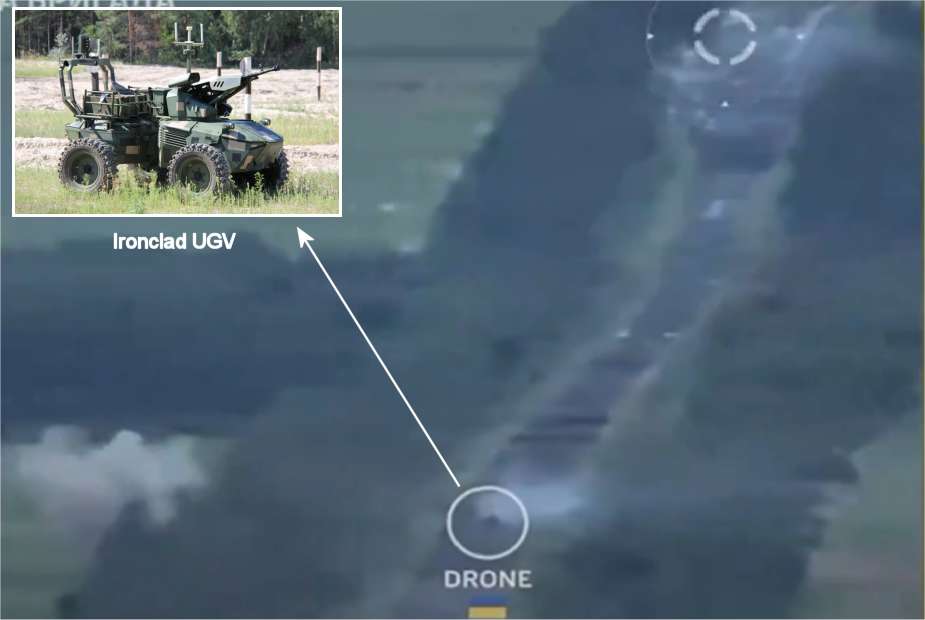- Army
- Conflicts in the world
- Israel - Iran conflict 2025
- Pakistan - India Conflict 2025
- Russia Ukraine War 2022
- Libya conflict day by day
- HAMAS - Israel War 2023
- Operation Serval in Mali French Army
- Sangaris operation Central African Republic
- Sangaris opération militaire République Centreafrique
- Ukraine - Russia conflict
- Syria conflict news
- Defence & Security Industry Technology
- Armies in the world
- Analysis Defense and Security Industry
- Conflicts in the world
- Navy
- Air
Ukrainian Ironclad UGV conducts strikes against Russian positions
The Ukrainian armed forces have shared exclusive footage showing their Unmanned Ground Vehicle (UGV), Ironclad, carrying out strikes against Russian military bases. While UAVs (Unmanned Aerial Vehicles) are very prolific in the war in Ukraine, UGVs also hold an important place, and their development is closely monitored.
Follow Army Recognition on Google News at this link

Footage showing their Unmanned Ground Vehicle (UGV), Ironclad, carrying out strikes against Russian military bases (Picture source: Ukrainian Mod)
These images provide a glimpse into the capabilities of the remote-controlled drone as it targets a Russian stronghold located near a road. Specific details of the drone's attack, including its impact and the exact model of the drone used, have not been disclosed. The drone involved in this offensive is likely the Ironclad, a cutting-edge innovation developed by the Ukrainian technology company Roboneers. This advanced drone redefines military strategy, contributing to the protection of soldiers' lives.
The specifications of the Ironclad include a net weight of 1,800 kilograms, a maximum payload capacity of 350 kilograms, and an operational range of up to 130 kilometers on a single charge. Its armored hull is designed to withstand 7.62 mm ammunition, providing significant protection in combat scenarios. The Ironclad is designed for rapid deployment, achieving up to 20 km/h speeds. It is equipped with a thermal camera, the Shablya M2 combat turret, and armor that protects it from small arms fire.
Its remote operational capability allows military personnel to conduct missions from safe distances, significantly reducing the risk to human operators. This is precisely the interest in UGVs, as both belligerents face significant recruitment problems and high losses. A good way to address this problem is the deployment of Unmanned Systems, which have the incredible advantage of not exposing their operators and thus saving valuable lives on either side.
Ukraine has announced plans to deploy 500,000 men on the front line, a relatively high number, and some people doubt Ukraine's ability to deploy so many men. Therefore, developing UGVs is a good way to counter this problem.
Other countries have also begun deploying UGVs, highlighting the global trend towards adopting these technologies in modern warfare. For instance, Estonia has sent 14 THeMIS UGVs configured for casualty evacuation to Ukraine, and the U.S. defense firm QinetiQ announced plans to send a batch of UGVs to Ukraine. These UGVs can perform a wide range of missions, including direct fire support, chemical, biological, radiological, and nuclear (CBRN) defense, and intelligence, surveillance, and reconnaissance (ISR). The potential of UGVs is vast, offering meaningful effects on the battlefield and providing lessons for future military efforts.
The adoption of UGVs by Ukraine also reflects a wider military strategy that focuses on reducing casualties and maximizing technological advantages. The decentralized approach to UAV adoption in Ukraine suggests that the country is open to experimenting with UGV applications. Simple applications like de-mining and intelligence collection have already proven viable and effective.
The use of UGVs like Ironclad on the front lines in Ukraine marks a significant shift in the dynamics of modern warfare. These unmanned systems not only enhance military capabilities but also offer a safer, more strategic approach to conflict. As the world watches Ukraine's use of these advanced technologies, it's clear that the future of warfare will increasingly rely on unmanned and autonomous systems.


























